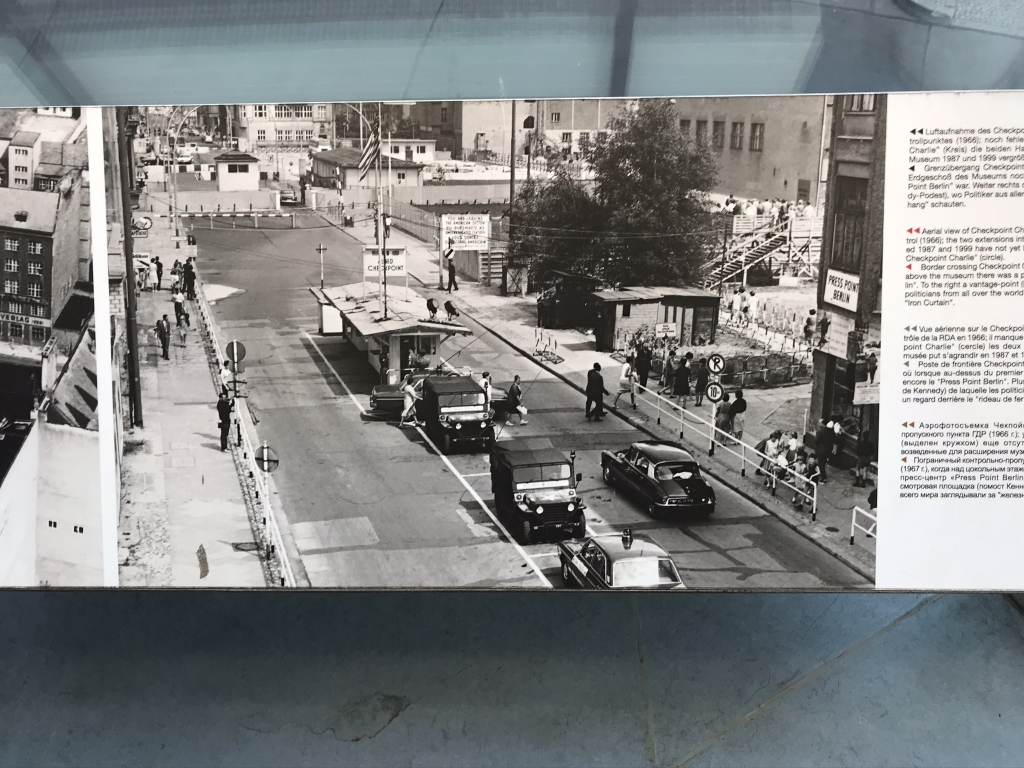Berlin is a city steeped in history. Of course, you can say the same thing about every other European city I've been through, but it's more true of Berlin than most of them, and some of those pivotal events, like the fall of the Berlin Wall, happened within my lifetime. It's one thing to see a fascinating artifact from centuries ago, but it's really something special to see museum exhibits dedicated to a world-changing event that I heard about on the evening news when I was growing up.
I spent four days in Berlin, September 4-7, 2020, during which I got to take in a great deal of this history, mostly in museums, some of which were more worthwhile than others.
Before deep-diving into history I have to explain the situation during the Cold War, because it was never fully explained to me back then. Growing up in the American Midwest in the Reagan '80s, I knew there were two countries called "East Germany" and "West Germany" and I was always hearing about this thing called the "Berlin Wall" being talked about as if it were the one barrier separating Freedom from Communism. I looked at maps and saw the border between East and West Germany, and thought "but that border doesn't run through Berlin, so how does that wall work?" It was never explained to me that "free" West Berlin wasn't part of West Germany, was actually an exclave deep within East Germany, and was entirely surrounded by the Wall. It was just assumed that everyone knew this even though I didn't. It wasn't until some years later while taking a German class in high school in the late '90s that I started to figure this out.
After WWII the victorious Allies--US, UK, France, and USSR--divided Berlin into four occupation zones, just as they had the rest of Germany. After relations quickly broke down between the USSR and the other three, the Soviet zone became "East Berlin" and the other three together became "West Berlin." While the East Germans fortified their border with West Germany, they still had this island of freedom right in the middle of it. If you were an East German who wanted to escape to the West in the first 16 years after the war, the Inner German Border may have been impassable, but if you could make it to Berlin, all you had to do was walk unhindered right into the city and you were home free. Naturally the East German government had a problem with this, which is why they built a wall around West Berlin in 1961.

Here you can see how the Wall completely surrounded West Berlin, which was virtually an island. To get in or out of West Berlin one either had to fly, drive on a dedicated highway with no exits in East Germany, or ride a non-stop express train to or from a West German city.
The most famous border crossing between West Berlin's American Sector and East Berlin was known as Checkpoint Charlie. We'll get into the reason for that name later. One of the most famous sights in Berlin, what every tourist wants a selfie in front of, is what appears to be the old guard shack from that border crossing.
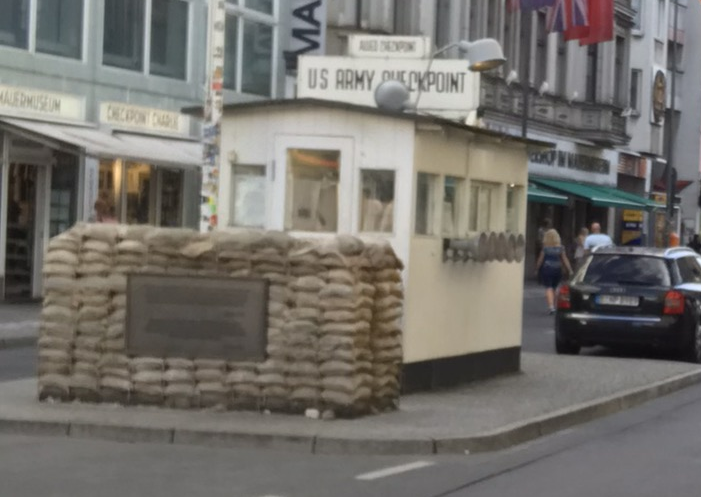
Guess what? This isn't the authentic guard shack. This is merely a replica of the one that stood here in 1961. Later in the '60s it was torn down and replaced with a second one, which was eventually torn down itself and replaced...I don't know how many they went through (I think four), but the last version is currently on display at the Allied Museum which is much further west of the city center. We'll be seeing it later.
Haus am Checkpoint Charlie
Next to the former site of the checkpoint was a museum known as Haus am Checkpoint Charlie, which I went through on Friday evening, September 4. This museum was quite a learning experience, but it was also what I call a firehose of information. It was full of walls of text and holy HELL was there a lot of text on those walls. I couldn't stay long enough to read all of that and take it in, because it would have taken many more hours which I did not have.
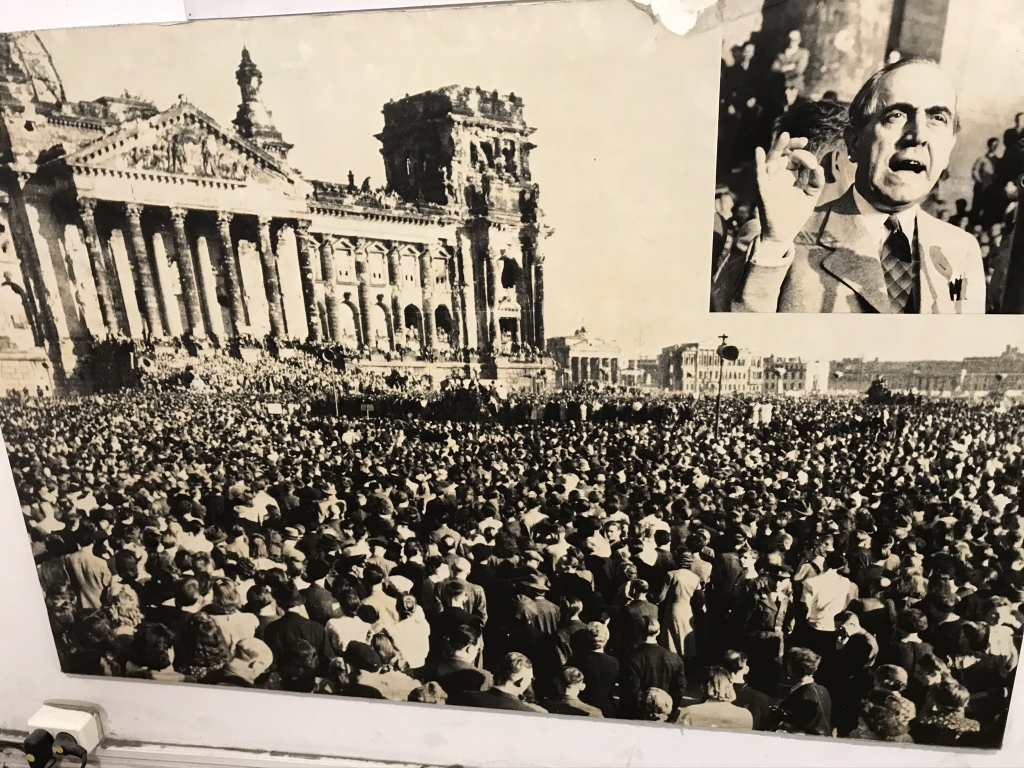
A huge demonstration in front of the Reichstag building in 1952. As you can see, the historic building had still not been repaired after it had been gutted by the Nazis' infamous Reichstag Fire a decade and a half earlier.
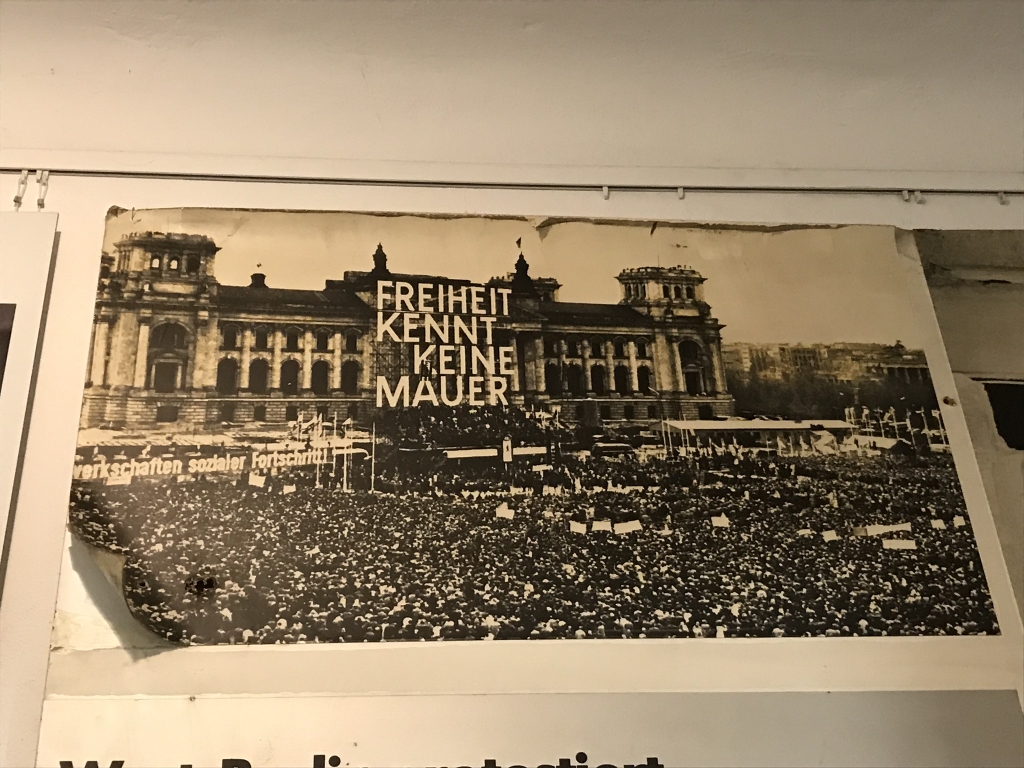
Another demonstration in front of the Reichstag building, probably in 1961. The sign says "Freedom knows no wall." This was in response to widespread reports that the East Germans were about to throw up a wall around West Berlin, which they flatly denied but eventually did anyway. The East German head of state, Walter Ulbricht, had said at a press conference, "No one has any intention of building a wall!" even as they were buying supplies for it. Two months later the first version of the Wall went up.
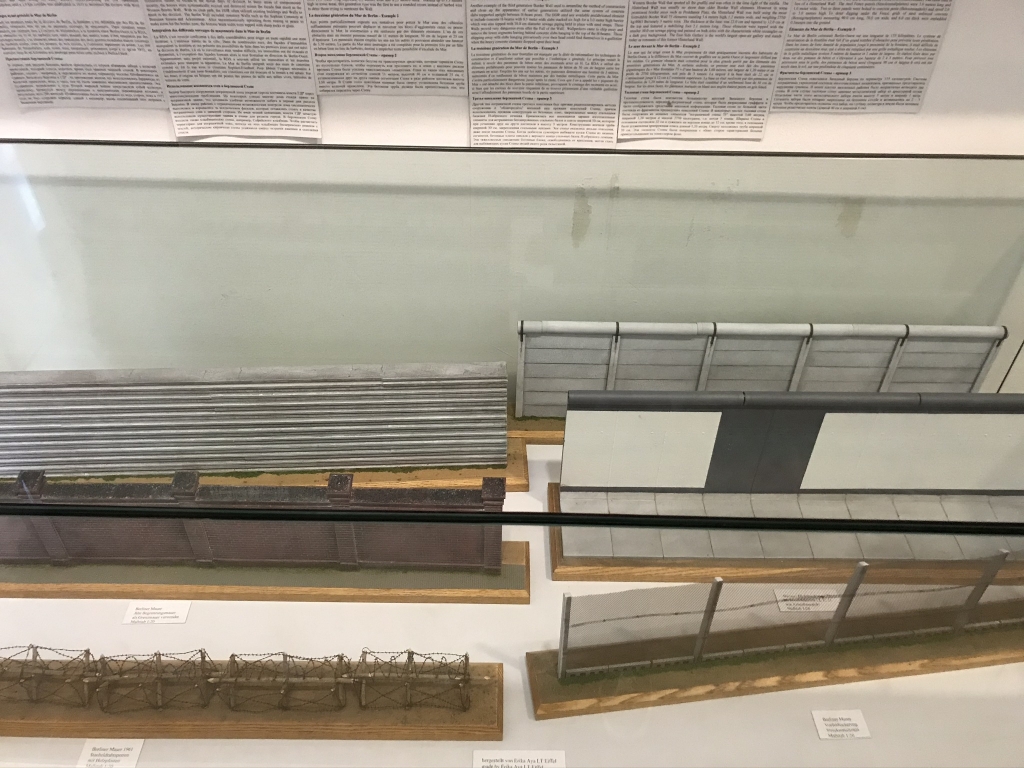
Scale models of sections of the Berlin Wall at different points in its evolution. The crude fence you see in the bottom left is the original version of the Wall that went up in 1961, while the tougher concrete walls are what replaced it in the '70s and '80s.
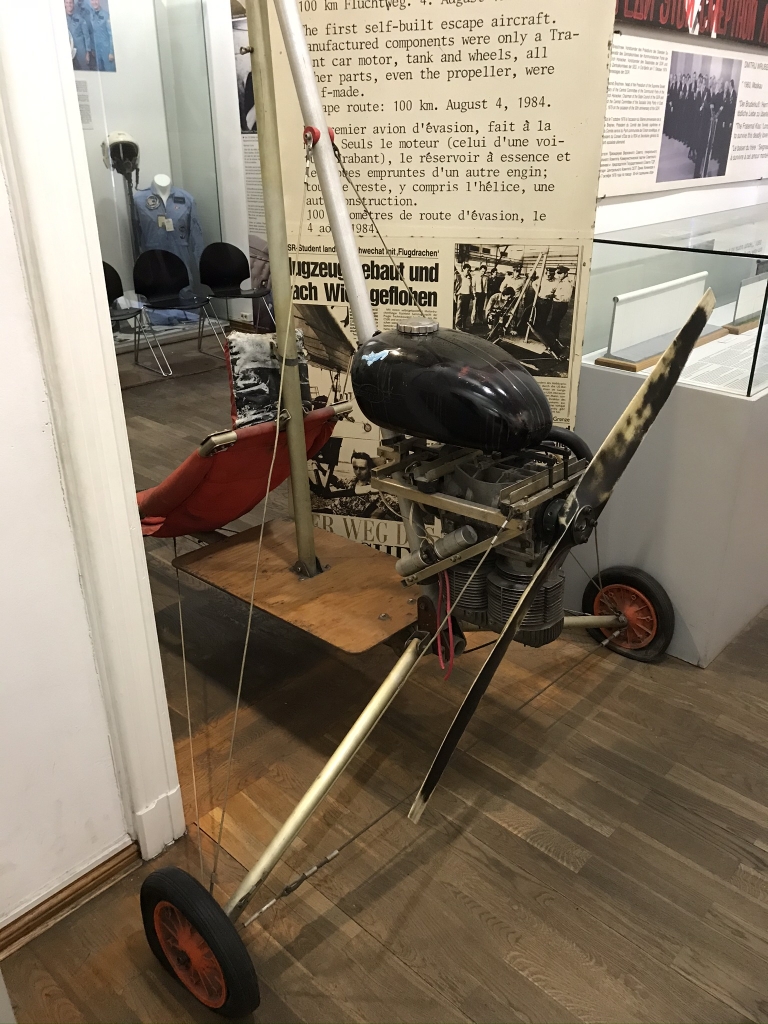
An East German actually escaped into the West in 1984 with this flying machine he put together with spare parts. That fits perfectly with something I learned at the DDR museum a couple days later: East Germans learned out of necessity to be genius engineers, because their shoddily-built cars and motorcycles were always breaking and genuine replacement parts were scarce. Taking a vehicle to a shop to a get fixed, mechanics often asked them "why don't you just do it yourself?" With that in mind, it's not at all surprising that an East German could slap this contraption together in his garage.
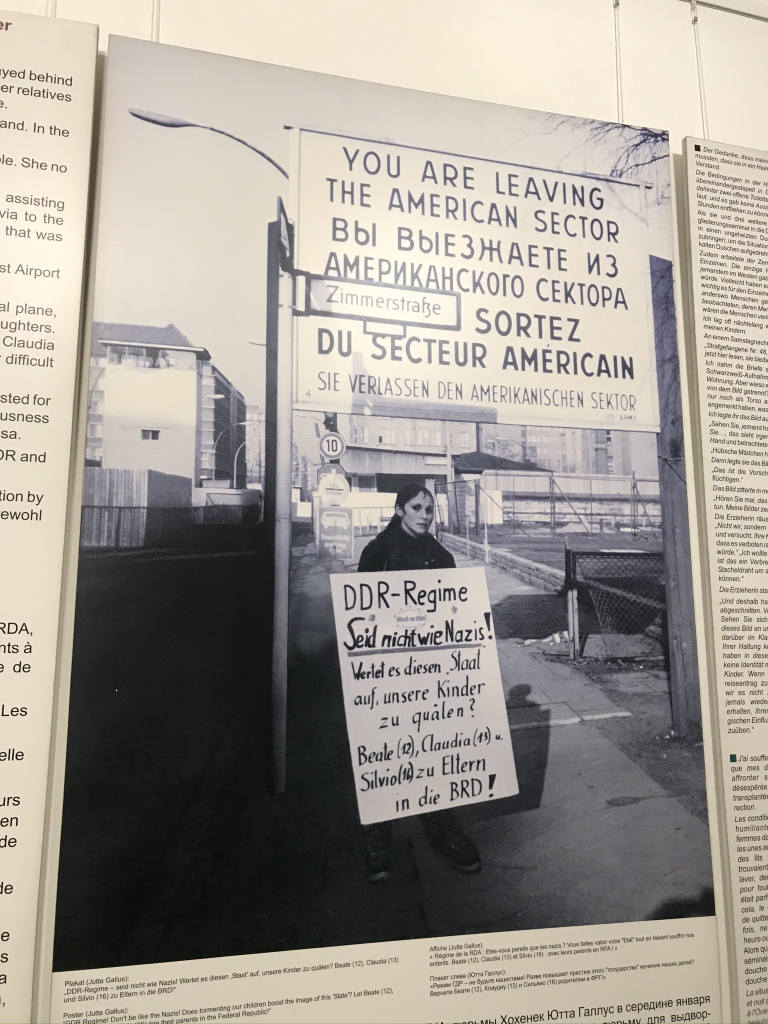
Now here I learned about a true story I'd never heard of before. In the picture you see Jutta Gallus. She was an East German who had been trying to get to the West and was imprisoned. The East Germans found her to be enough of a nuisance that they let her go and live on the other side of the border...but without her kids who were forced to stay behind and live in foster homes. Separating a mother from her kids is usually a bad idea. She moved to West Berlin and protested for most of the '80s outside Checkpoint Charlie like you see in the picture. The sign she is holding says "GDR Regime: don't be like Nazis! Is it worth the state to torment our children? Return Beate (12), Claudia (13) and Silvio (16) to their parents in the FRG!" (FRG meaning Federal Republic of Germany, i.e. West Germany) The Eastern government finally gave in in 1988 only a year before the Wall fell.
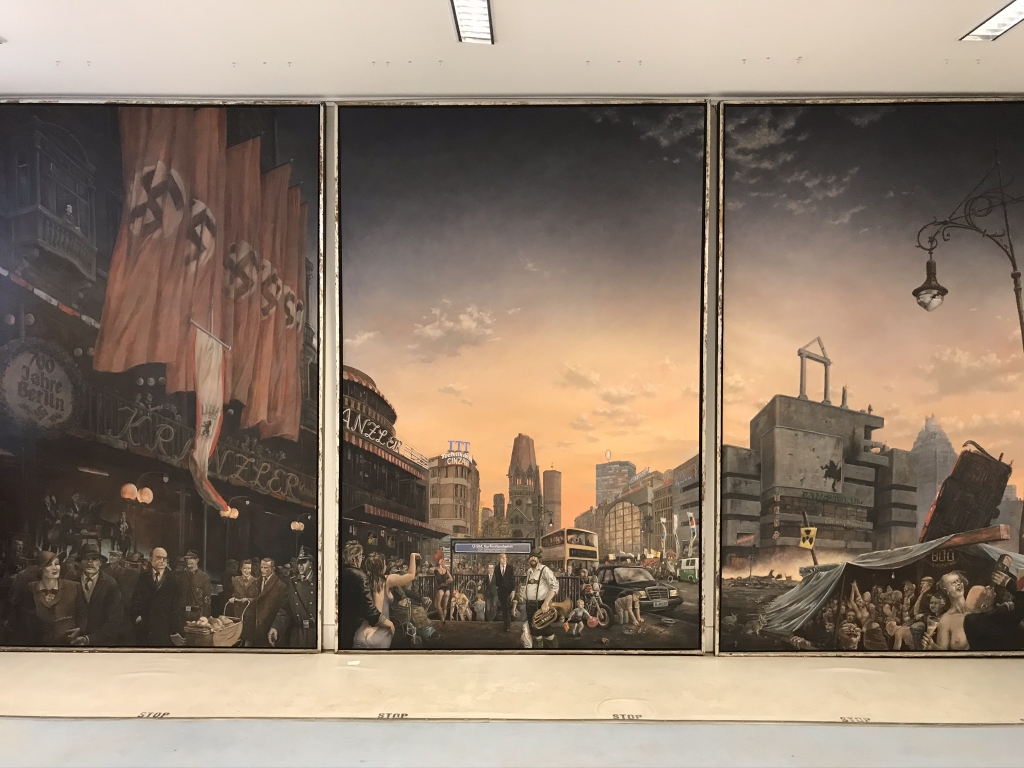
This eye-catching three-part mural was painted in 1987. On the left you see Berliners celebrating the city's 700th anniversary in 1937. In the middle, the 750th anniversary party in what was the present when this was painted. Then on the right, the artist's vision of what the 800th anniversary bash would look like in 2037. People in the '80s always seemed to think that a nuclear holocaust was just around the corner, didn't they?
Checkpoint Charlie in 1966. You'll notice that's a different guard house than the early-'60s version that is replicated outside. See that building on the right with the "Press Point Berlin" sign? This very museum is in that building.
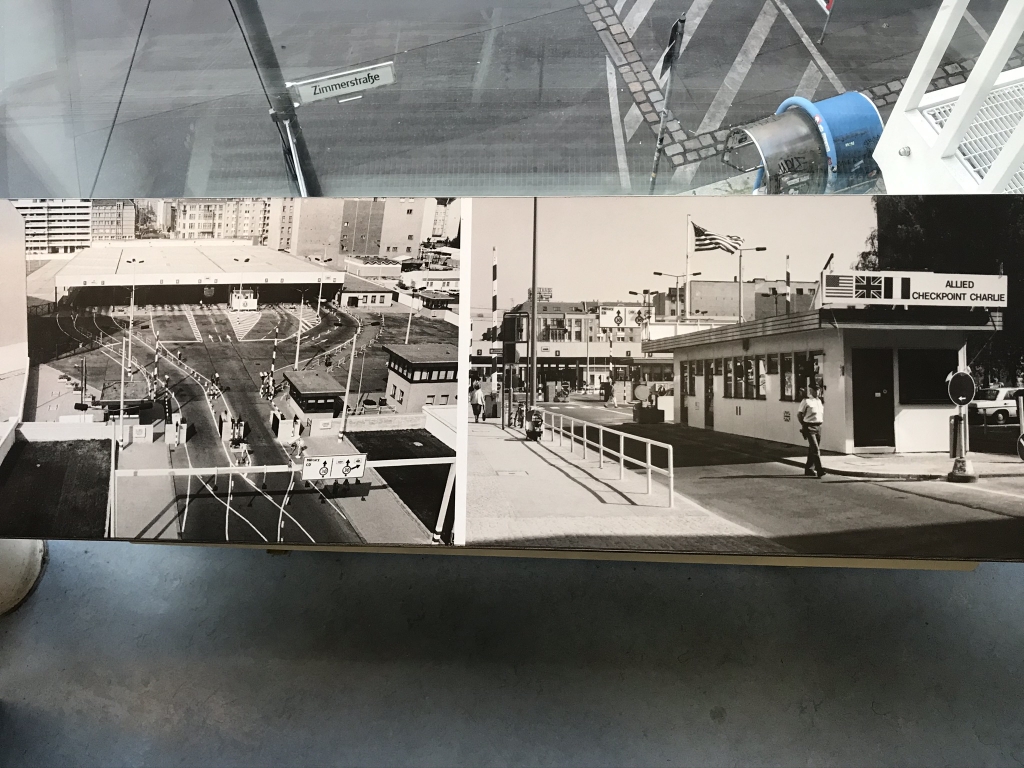
The final version of Charlie that was installed in 1986. We'll be seeing that guard house in person soon.
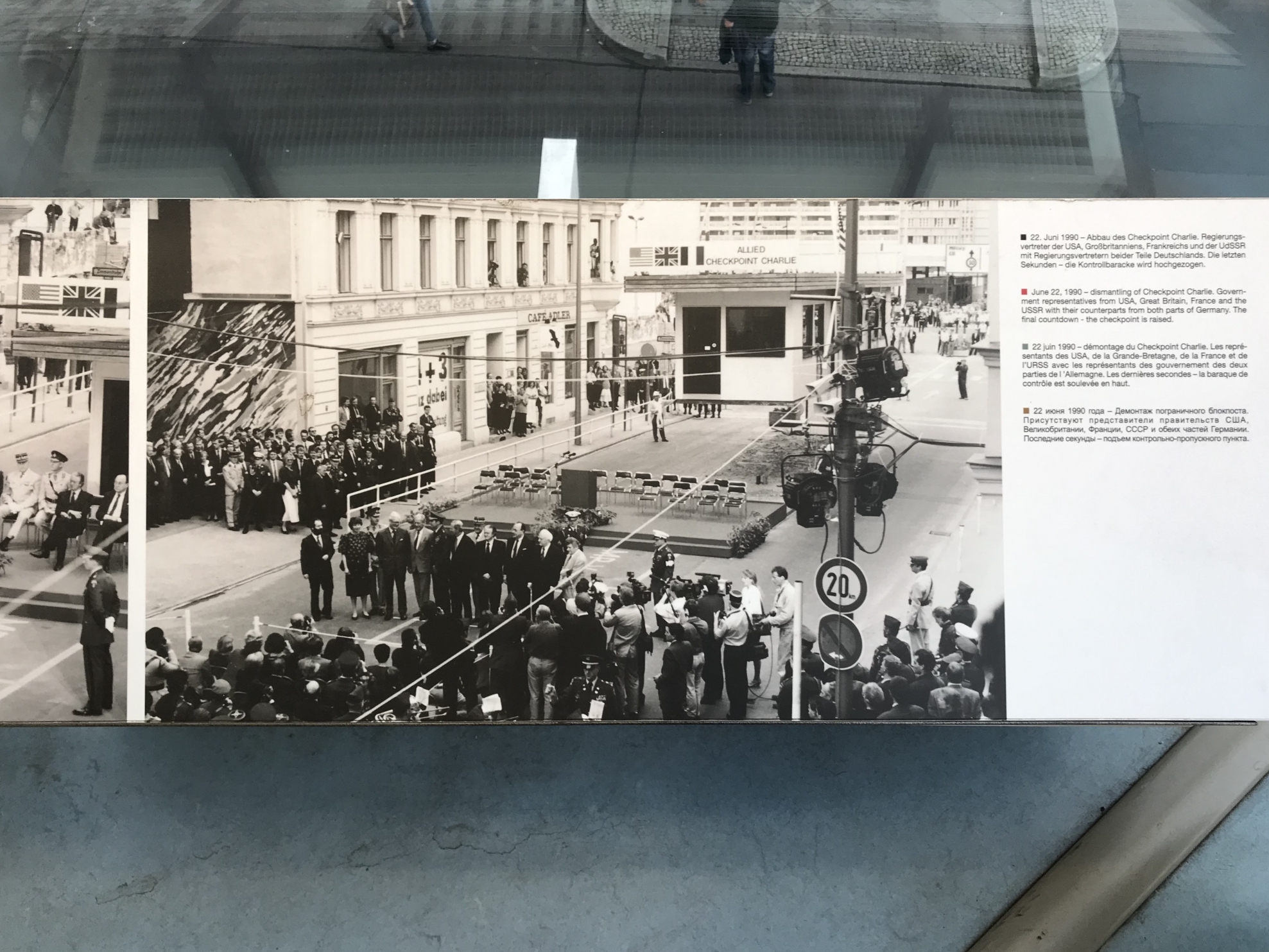
In a historic ceremony on June 22, 1990, a crane removed the Checkpoint Charlie guard house, marking the end of an era. The shack was moved to the Allied Museum.
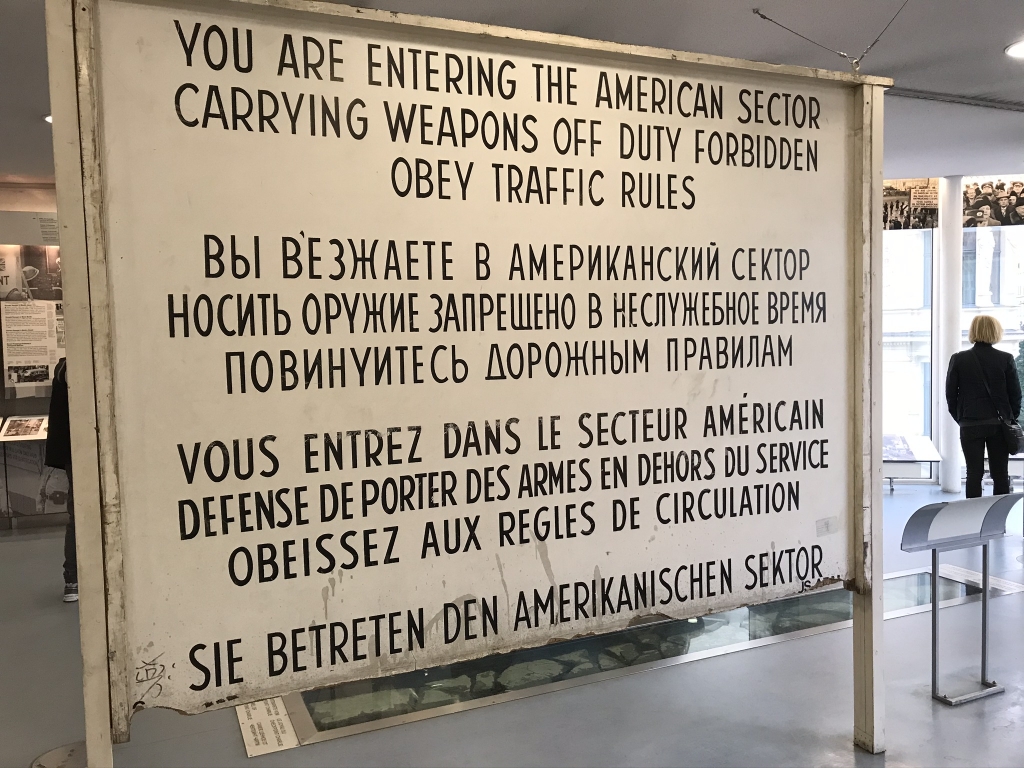
Everyone wants to see that famous "You are leaving the American sector" sign. Now when was the last time you saw the other side of it?
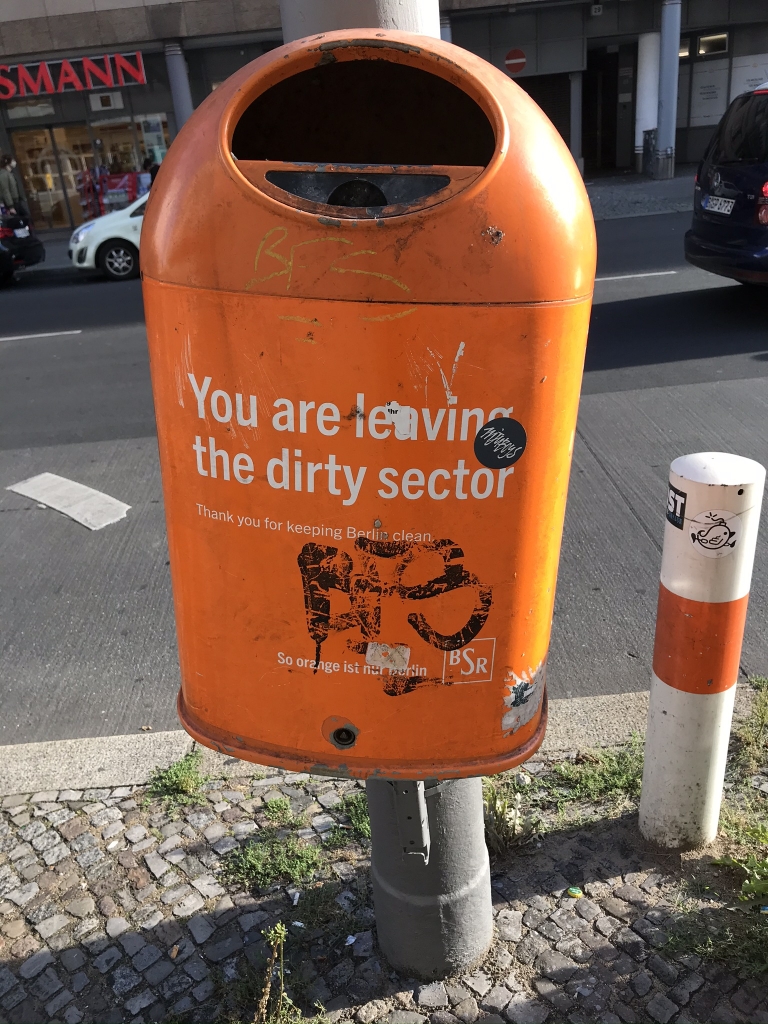
This is all anecdotal, so correct me if I'm wrong, but I used to work with someone in San Antonio who, as a young US Army private in the late '80s, had been stationed in West Berlin for his first assignment. He said that because the post-WWII occupation of Berlin didn't end until reunification in 1990, East Berlin was still recognized by the Western Bloc as only the Soviet Occupation Zone, and thus not legally part of East Germany for that entire time period. He also said that the treaty which had set up this system of occupation zones mandated freedom of movement between all four, and that to be able to claim they were following this, the Soviets regularly allowed the occupying military personnel in West Berlin to go on one-day bus tours in East Berlin. Because of the legal status of East Berlin, and the Western powers' refusal to recognize it as East German territory, he said that everyone participating in these tours were instructed to never show their identity documents to any East German authorities if asked, but rather to respond "I can only show them to the Soviets" because the Western powers only recognized the Soviet Union as having any authority in East Berlin.
Allied Museum
Now then, let's move on to another museum focusing on Cold War occupied Berlin: the Alliiertenmuseum (Allied Museum). It was on Saturday afternoon, September 5, 2020, that I went through this one. If you're interested in this topic enough to go through the Checkpoint Charlie museum, you kind of have to visit this place too. Unlike the other museums I visited, it's not downtown, but rather in the Dahlem neighborhood in the southwest part of the city. It's on Clayallee, a street named after the US Army General Lucius Clay who had been the governor of the American occupation zone of West Germany, and was also responsible for making the Berlin Airlift happen. To get there one must take the U3 to either Thielplatz or Oskar-Helene-Heim station. (I, however, stepped off the train at too early at Heidelberger Platz and had to hike down Clayallee for a little while.) If you want to take a selfie in front of a real authentic Checkpoint Charlie guard shack, the Allied Museum is where you must go.
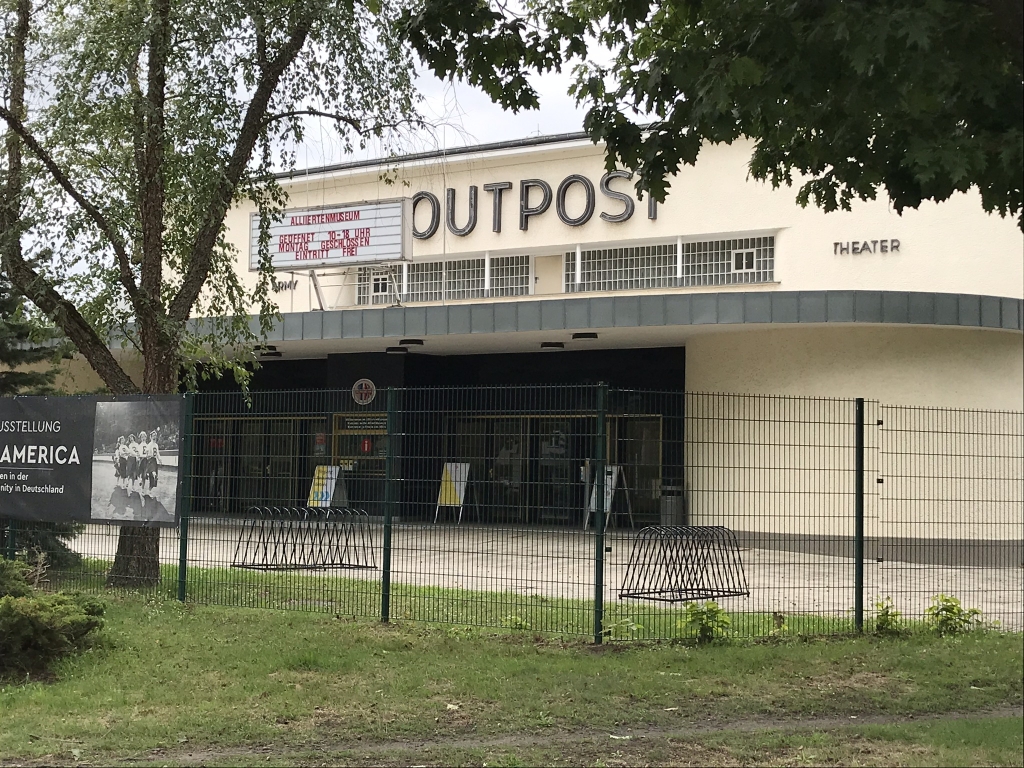
Here's the entrance to the museum. It used to be part of a US Army post during the Cold War, and this building was formerly the base theater.
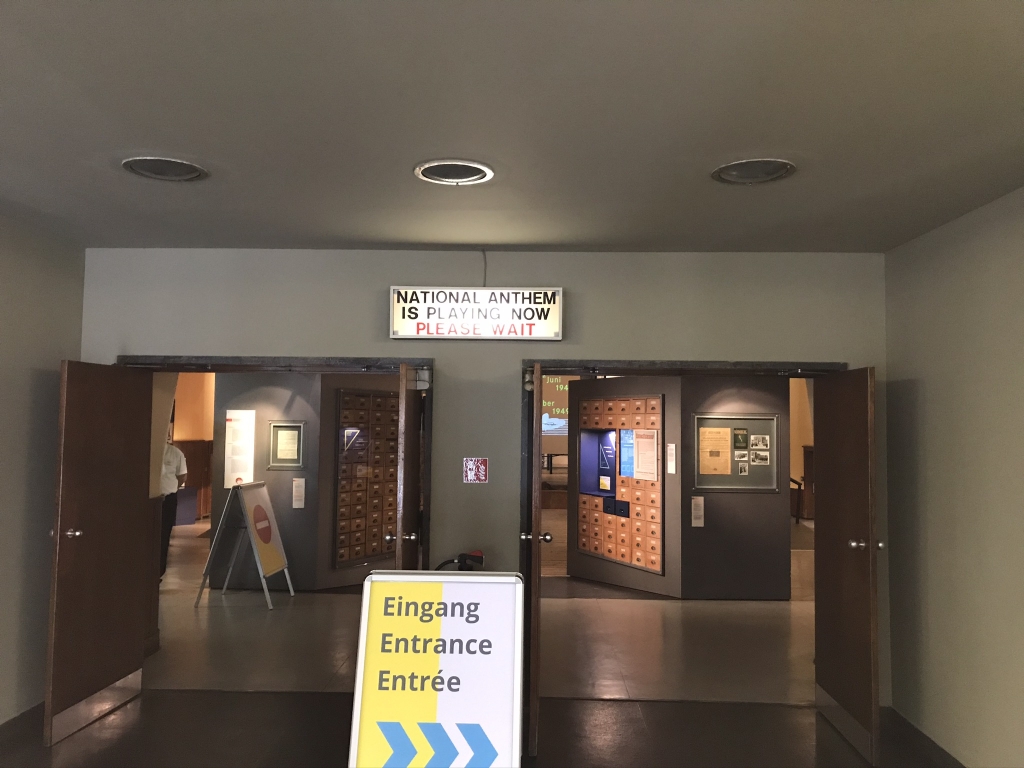
Just inside the theater, which they've kept well-preserved.
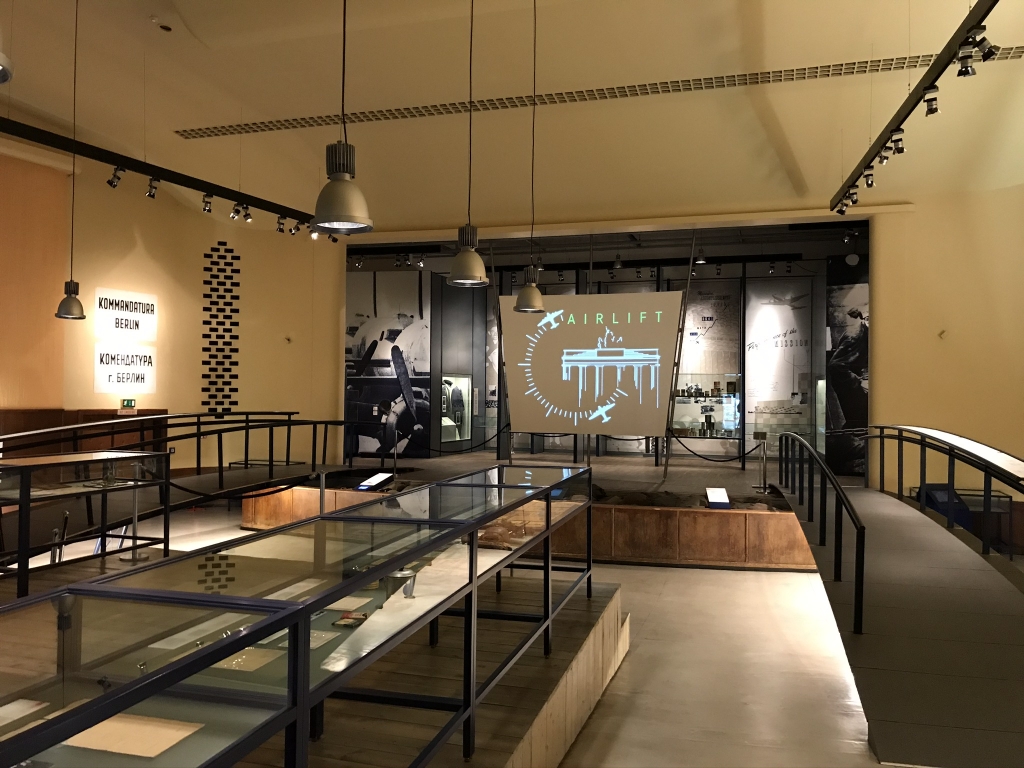
The theater is filled with artifacts from the 1945-1990 occupation of Berlin by the four WWII Allies, who quickly became divided after the war. Up by the screen is a whole bunch of exhibits related to the Berlin Airlift of 1948.
After WWII, when Berlin was divided into four occupation zones, each of the four countries maintained military garrisons in their sectors, through which they governed them. When the alliance between the USSR and the other three broke down, the Soviets blockaded West Berlin preventing any food or anything else from getting in. To keep the city alive, the American and British militaries organized a massive operation in which hundreds of cargo planes brought in all the food and supplies Berliners desperately needed; this was the Berlin Airlift.
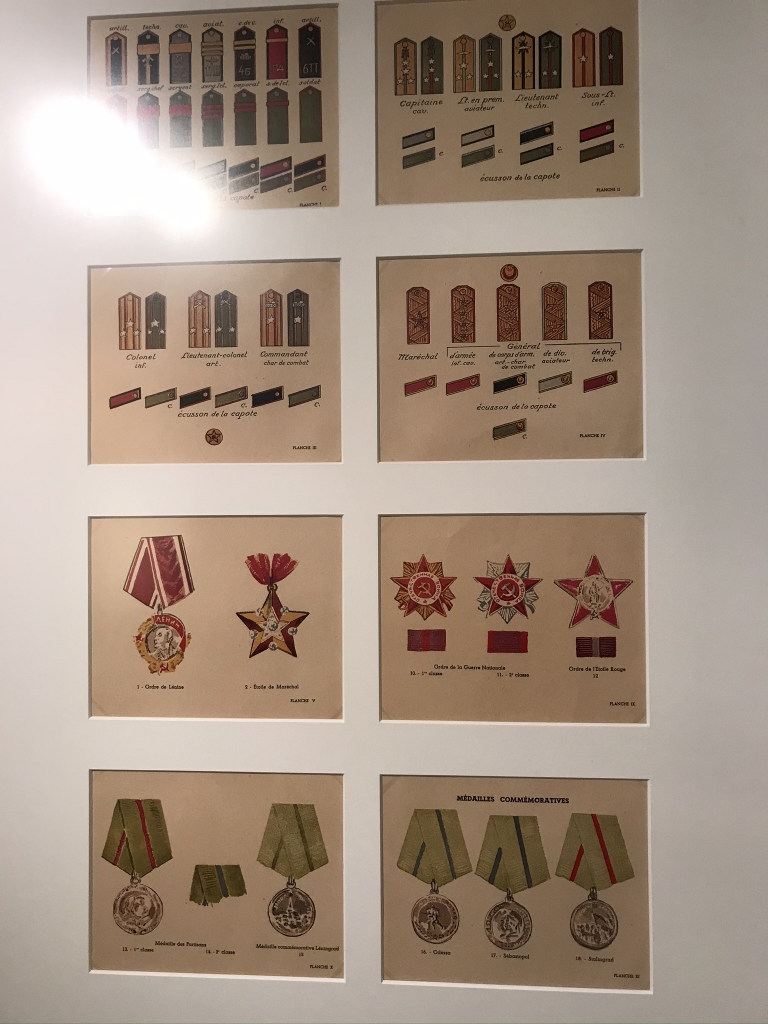
Soviet rank insignia and medals.
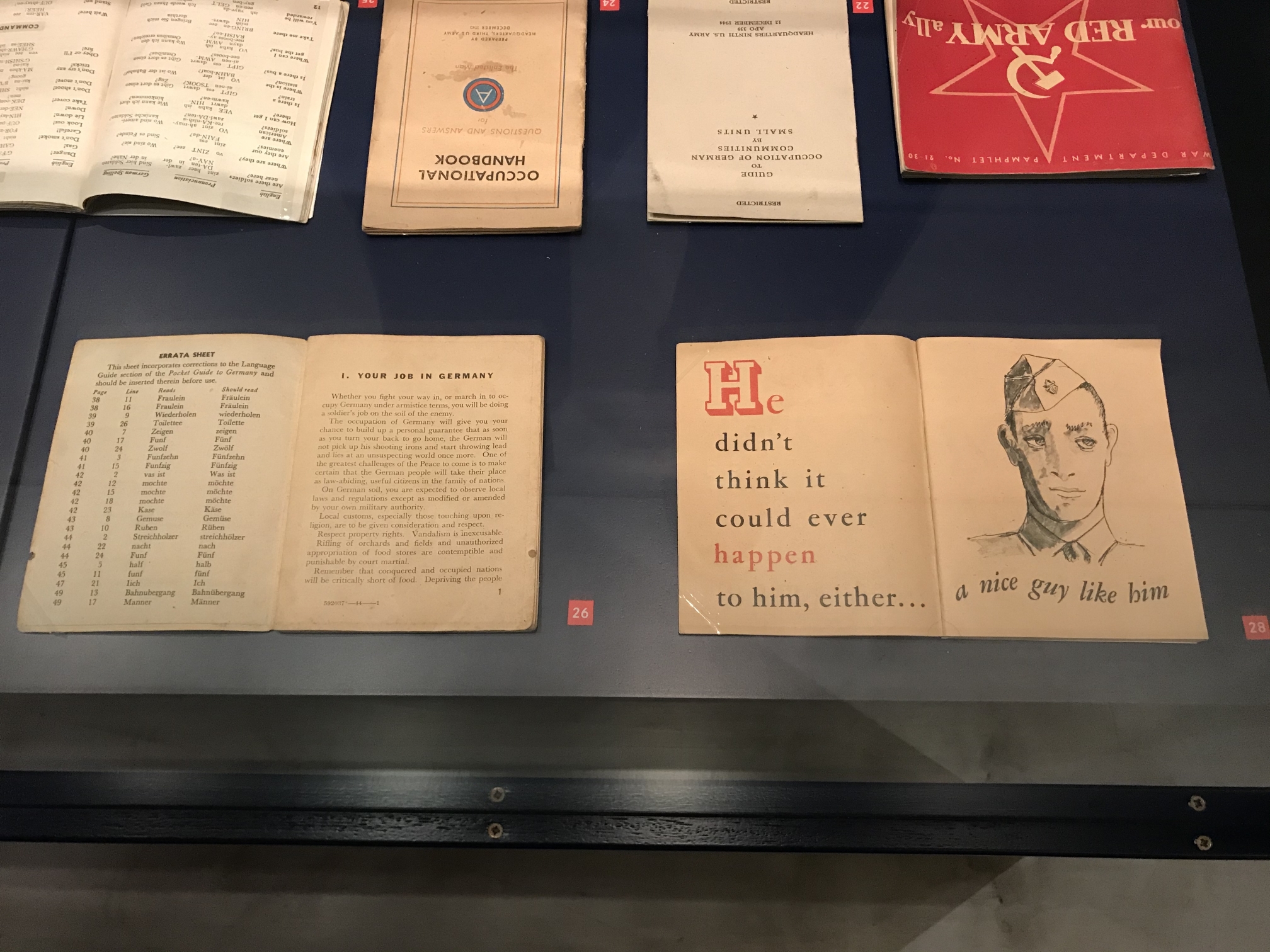
Some pamphlets for US Army soldiers stationed in West Berlin. Notice there's one in the top right called "Our Red Army Ally." That must have been published really soon after WWII ended, before relations between the Soviets and the other Allies broke down. That ridiculous-looking one in the bottom right is about STDs, in case you were wondering.
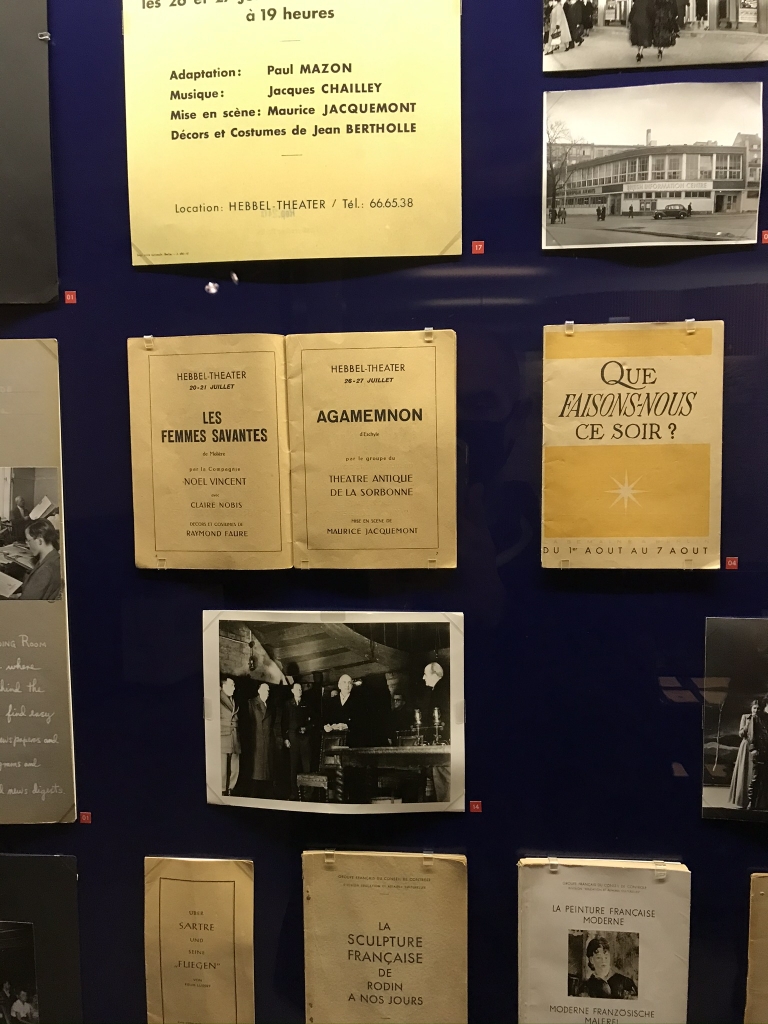
Everyone remembers the Cold War as being US vs. USSR; it's often forgotten that France had soldiers stationed in West Berlin during that time, and they had their own little community too.
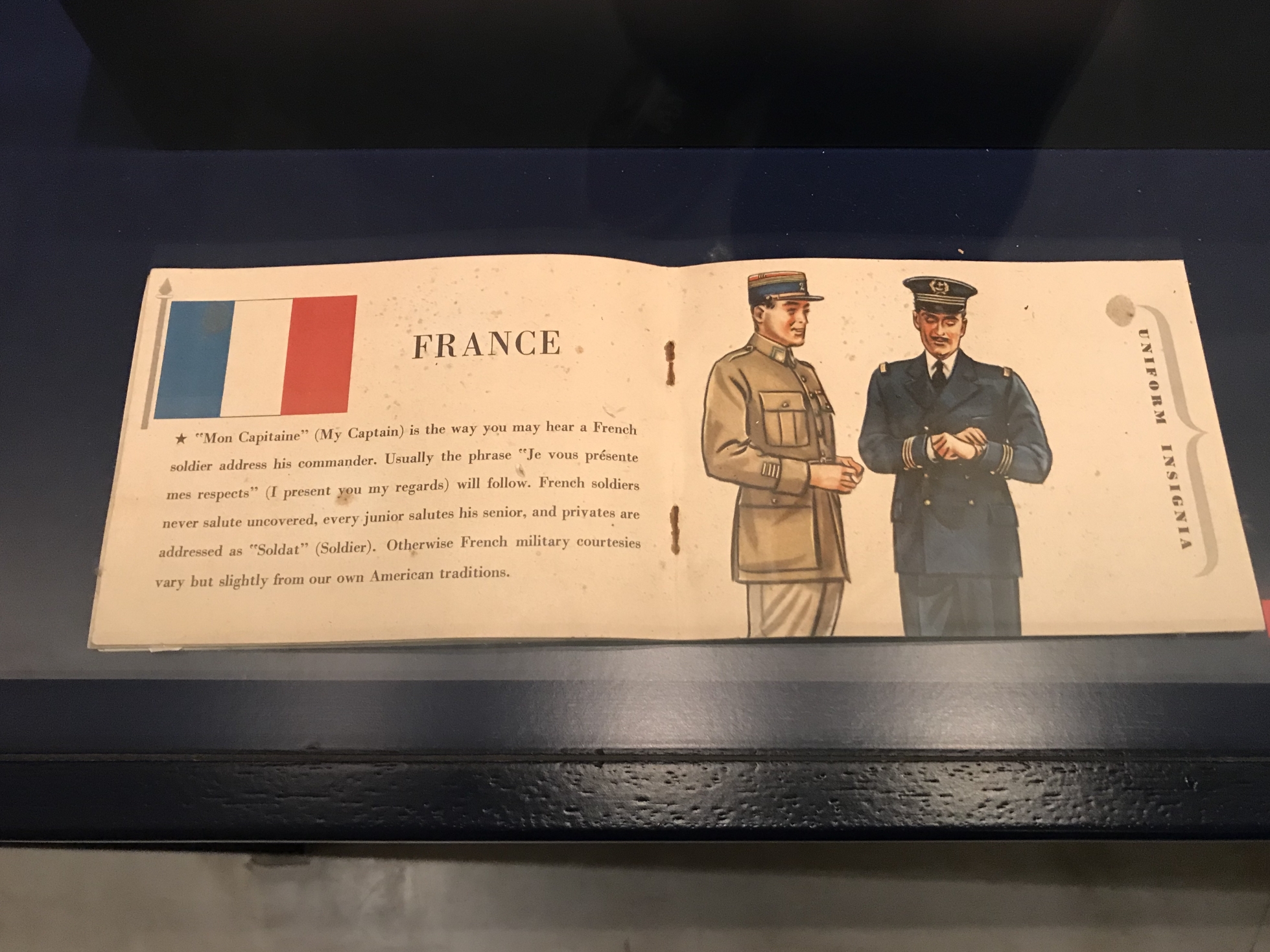
Another publication for American troops to get familiar with their other Allies' military customs and courtesies.
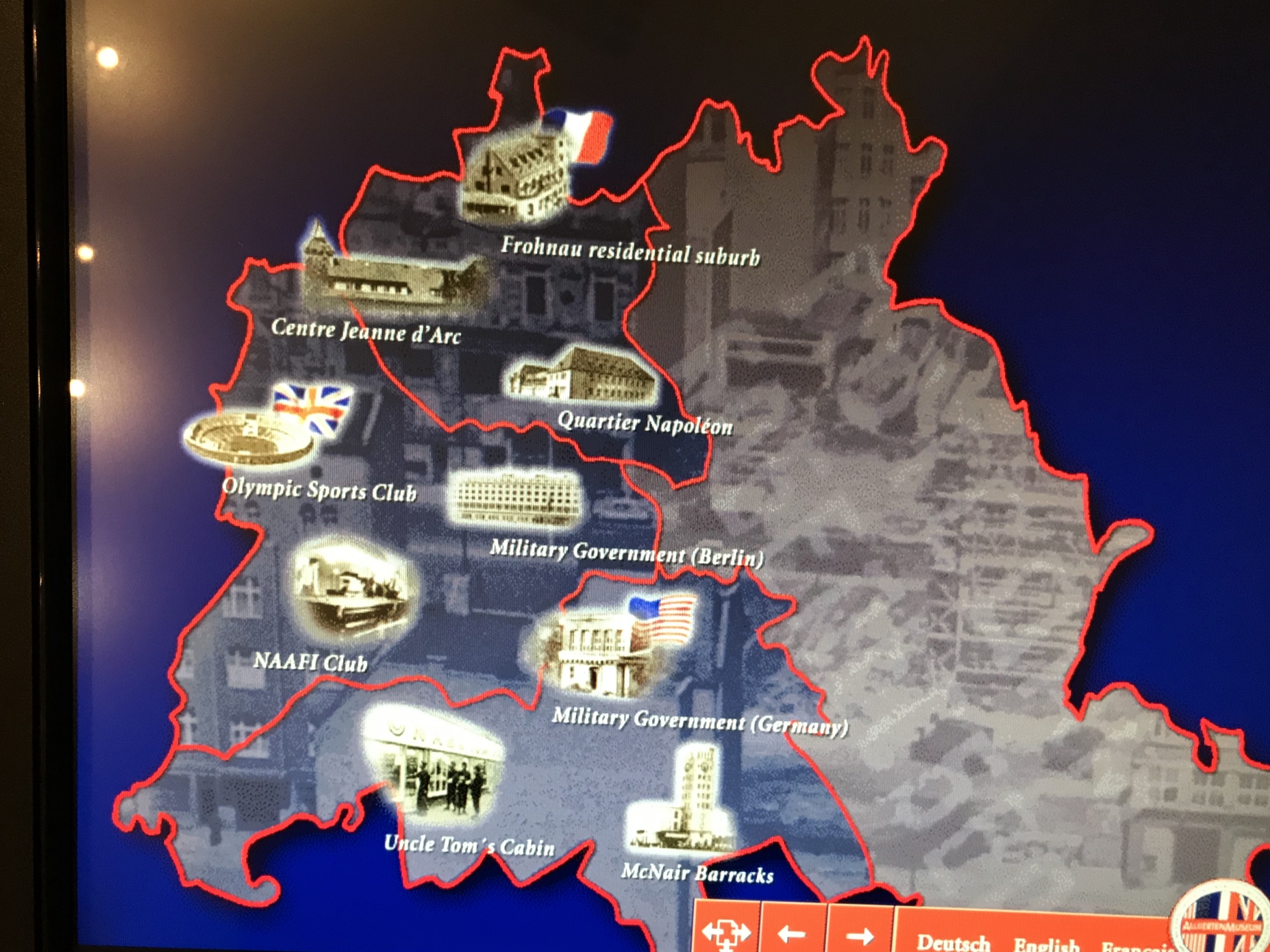
This is a map of the military amenities for the US, UK, and French troops who were serving in Berlin throughout the Cold War. Yes, the US zone had a troop store called "Uncle Tom's Cabin," because apparently people have a hard time remembering what that book was actually about. To this day the U-Bahn stop near its location is named "Onkel-Toms-Hütte."
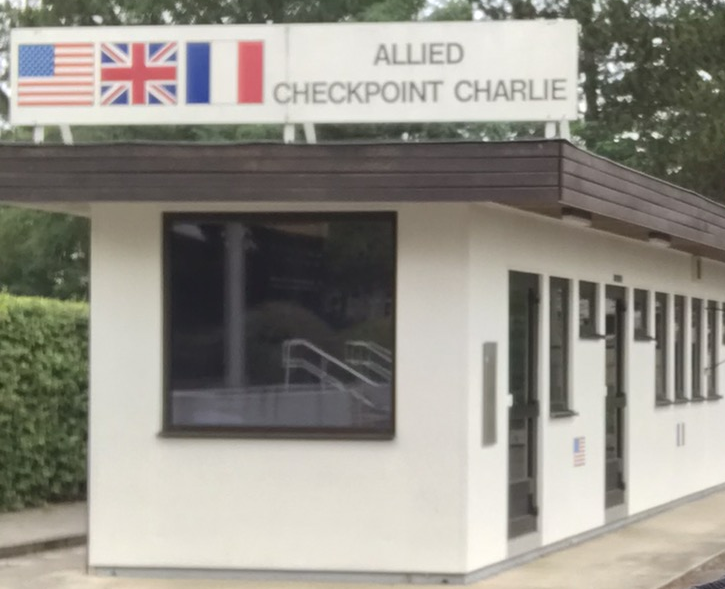
This is it, the real Checkpoint Charlie. Well, at least, the most recent in a succession of guard shacks that were at that spot. This one went up in 1986 and, as we saw at the other museum, was removed by a crane in a ceremony in 1990 after the Wall came down.
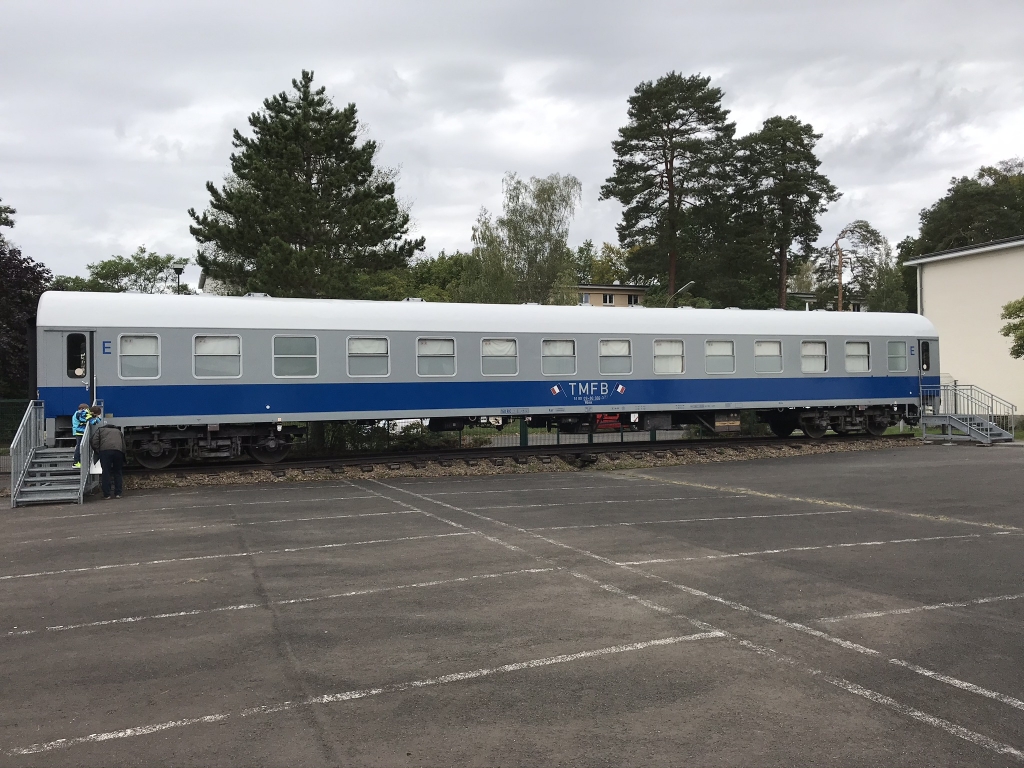
While the Americans and British moved their troops in and out of Berlin by air (through Tempelhof and Gatow airfields, respectively), France was close enough that they could just move their troops by rail. Railcars like this one transported French soldiers back and forth between Strasbourg and West Berlin, directly with no stops.
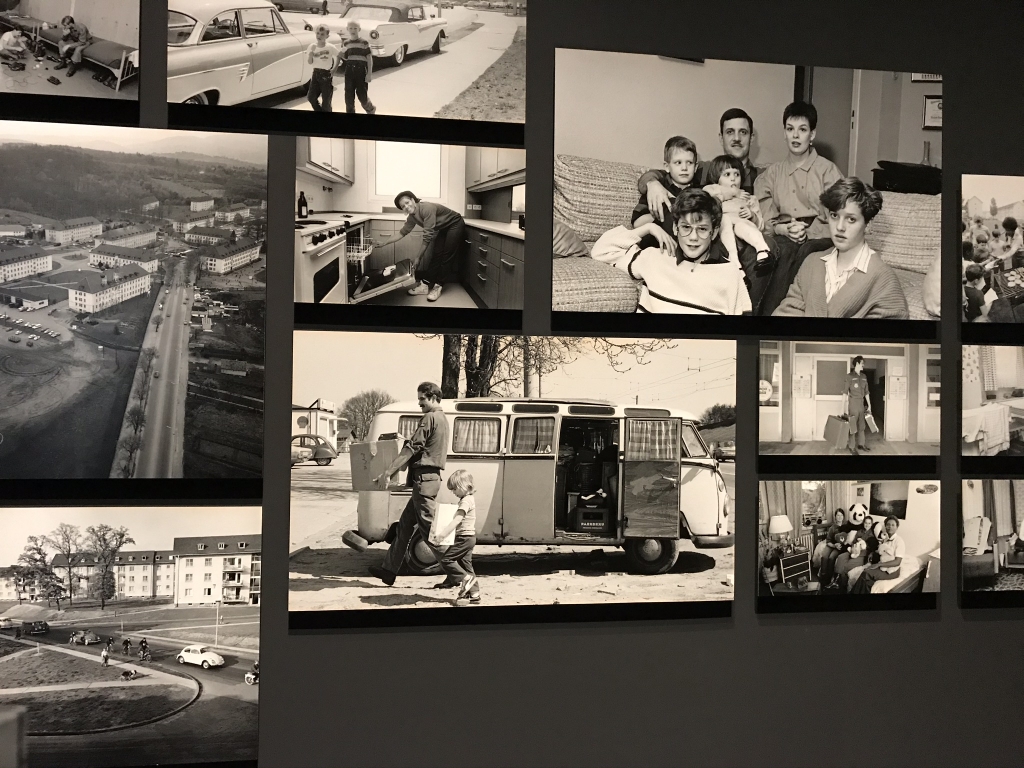
Now this was really interesting. In another building on the museum grounds, there was this large photo exhibit. A photojournalist spent four decades around American troops and their families in West Germany and West Berlin, documenting what their daily lives were like.
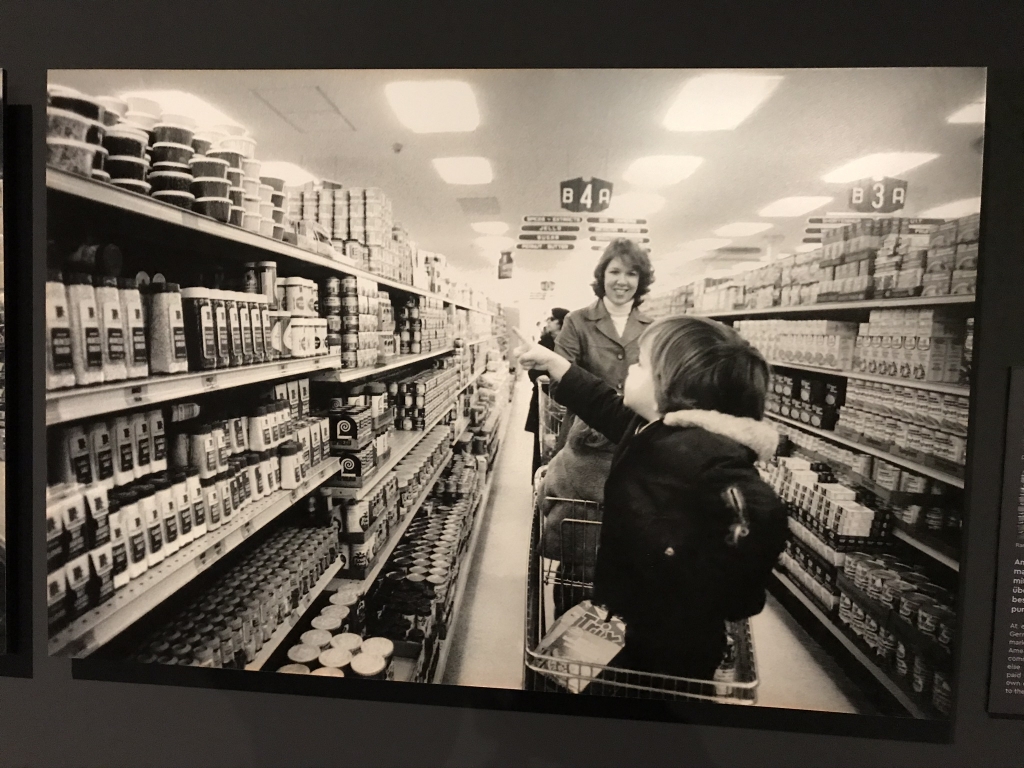
The Ramstein Air Base commissary in 1976.
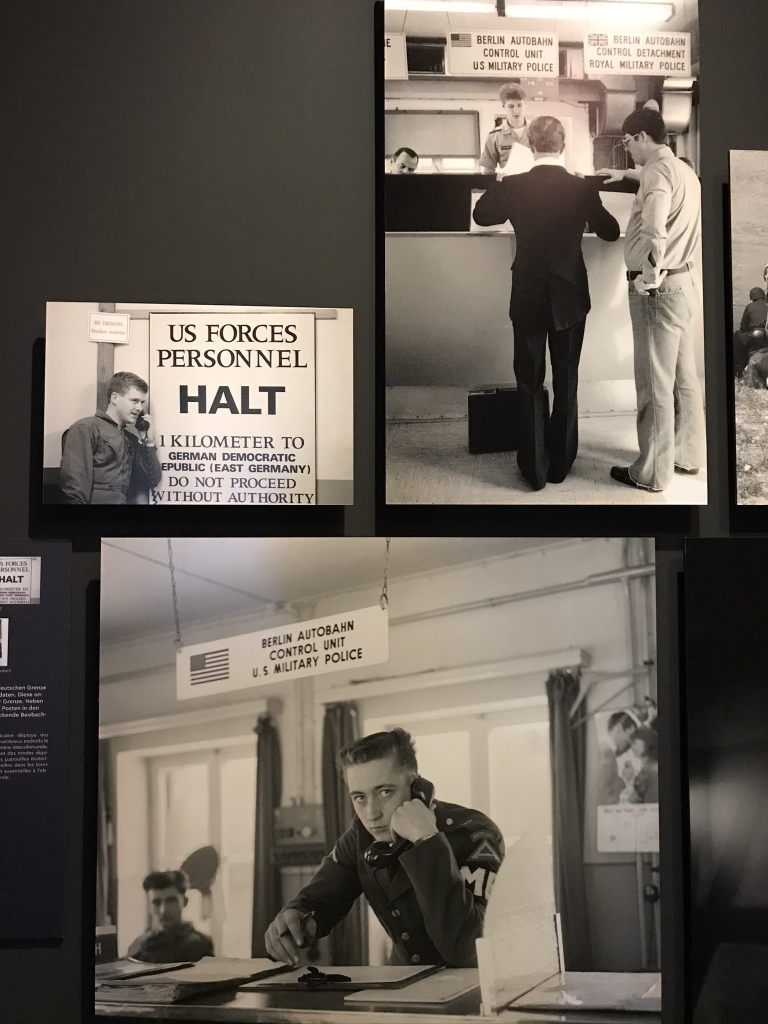
Now you've heard all about Checkpoint Charlie. That name "Charlie" is simply the letter C from the NATO Alphabet. That implies there must have also been checkpoints named A(lpha) and B(ravo). Where were they? These photos are from Checkpoint Alpha, on the Inner German Border between the towns of Helmstedt, West Germany and Marienborn, East Germany. The top right photo is from 1979 and the bottom is from 1963. Among the very few land routes connecting West Berlin with West Germany was a handful of dedicated no-exit highways; one of these had one end at Alpha and the other at Bravo, which was in West Berlin's Wannsee neighborhood.
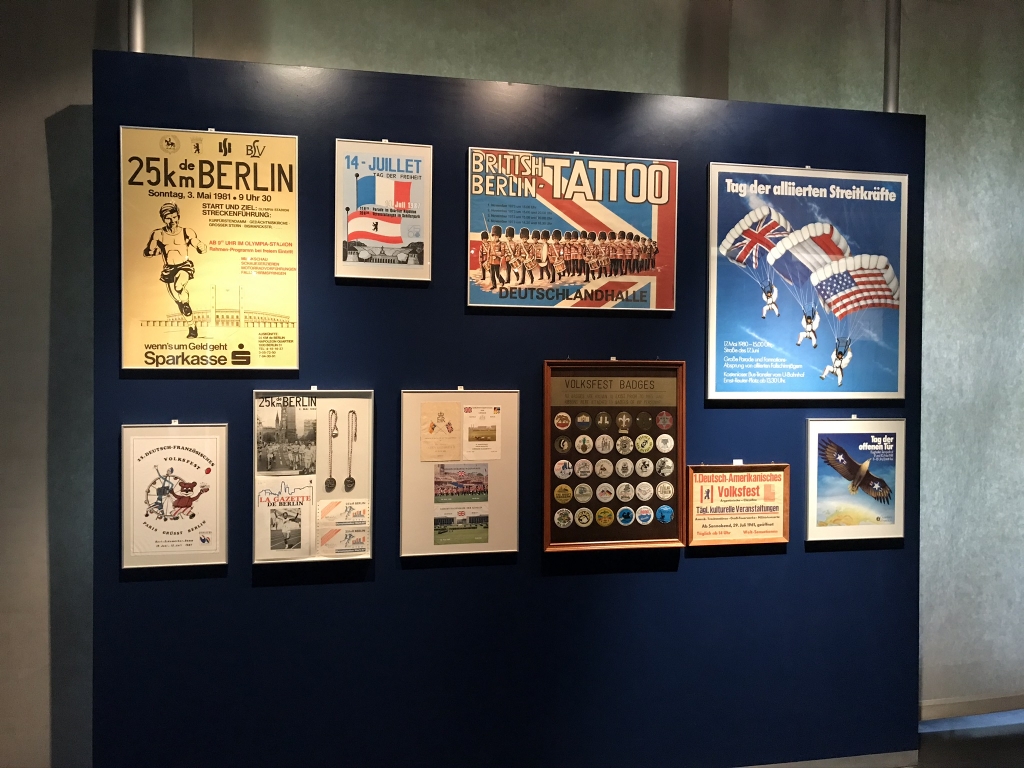
Some more interesting artifacts from the occupation. Another photo I had to take as a reminder that it wasn't only about the Americans and Soviets; the British and French were there too. The British Berlin Tattoo--using "tattoo" in its archaic sense meaning "military formation"--was an annual parade put on by the British Army. The 25km de Berlin was an annual running race, originally put on by the French Army, which still occurs to this day. The poster between those two, the one that says "14-Juillet," (July 14th) is clearly advertising a Bastille Day celebration, while the bottom left is for the German-French Volksfest.
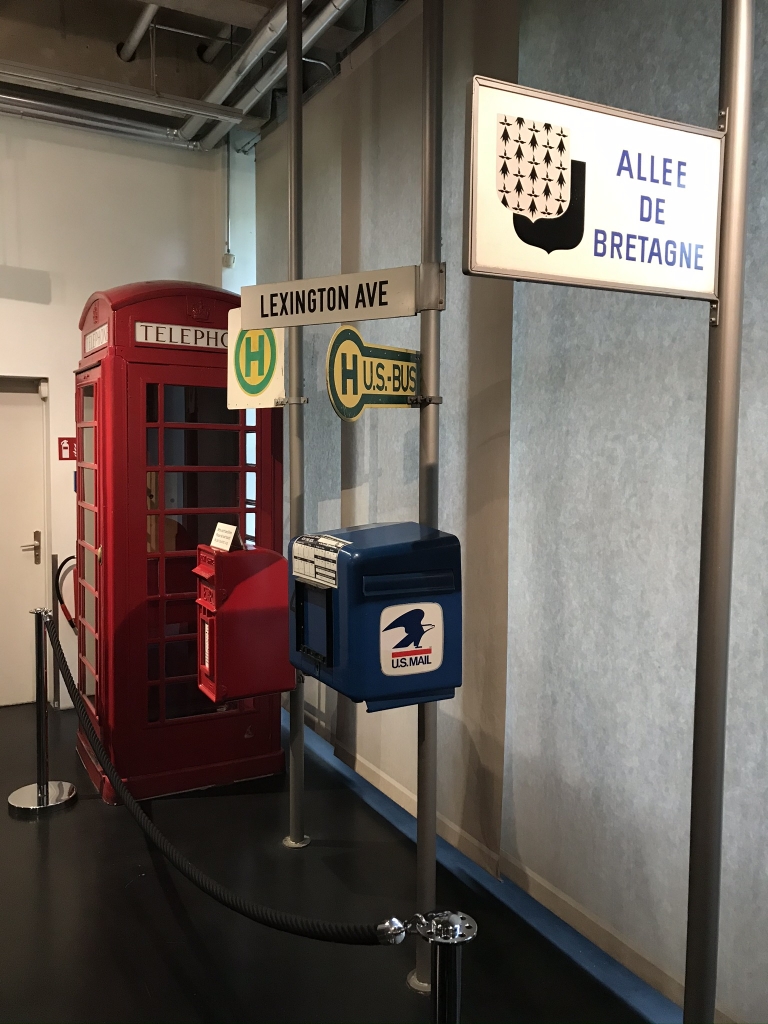
Iconic British red phone booth and post box, not-so-iconic-but-still-recognizable blue American mail box, and bus stop and street name signs from all three West Berlin Allies.
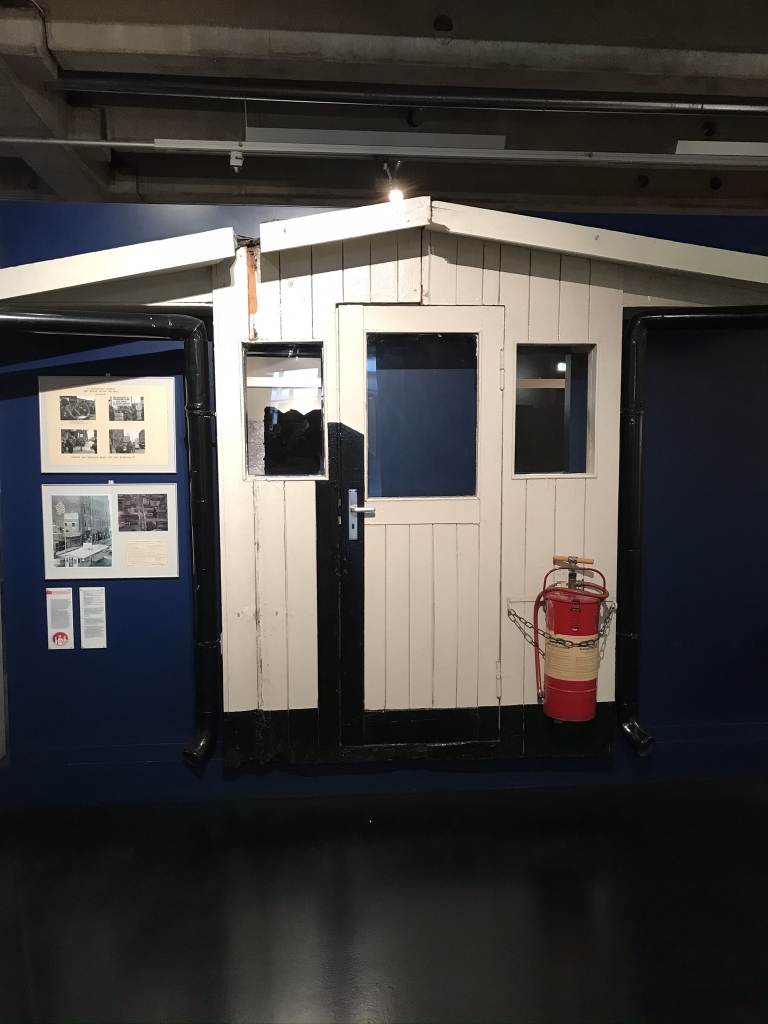
This is all that's left of the guard shack that stood at Checkpoint Charlie in the late 1960s. Further up on this page we saw a photo of the whole thing when it was still there.

Memorabilia from the British occupation.
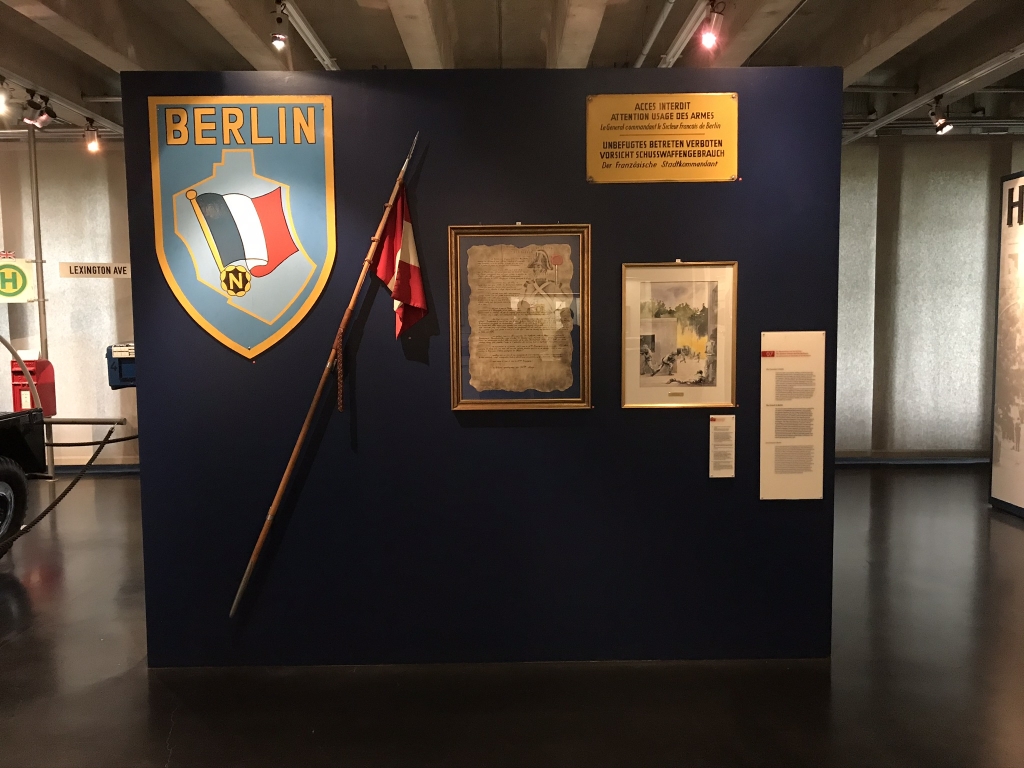
Some things the French left behind. They had the smallest of the four occupation zones. According to a nearby informational sign, most of their troops were draftees doing their mandatory service.
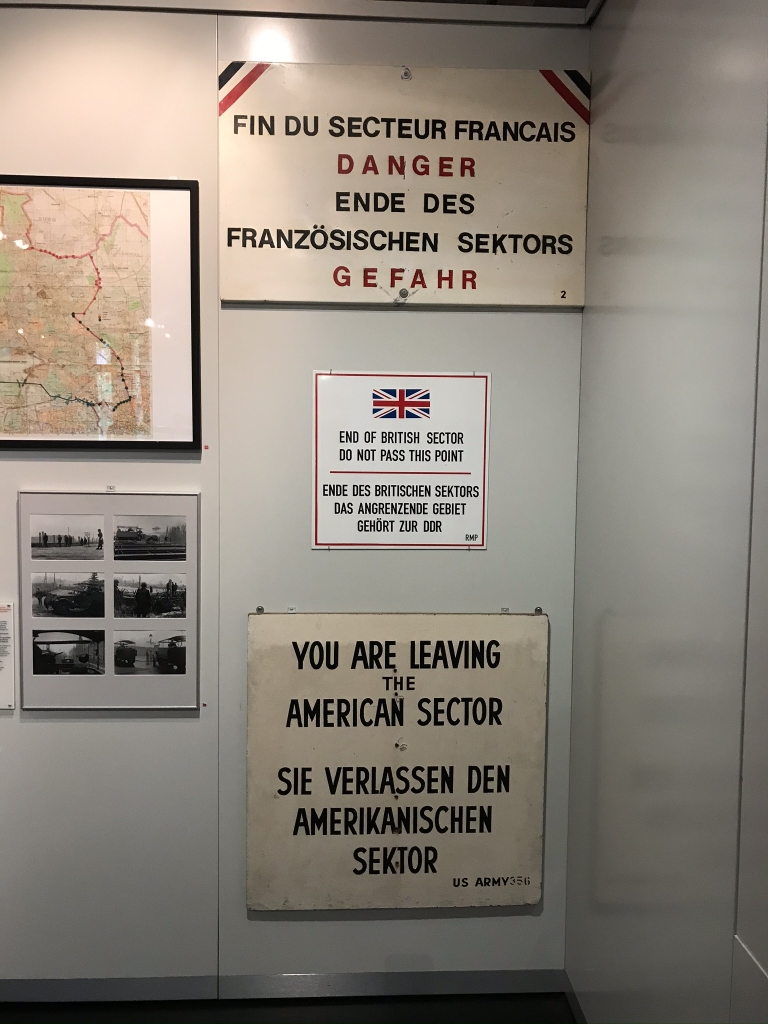
Signs posted at the borders of the different occupation zones. We've all seen that "You are leaving the American sector" sign, so here's their equivalents from the French and British sectors along with another American one.
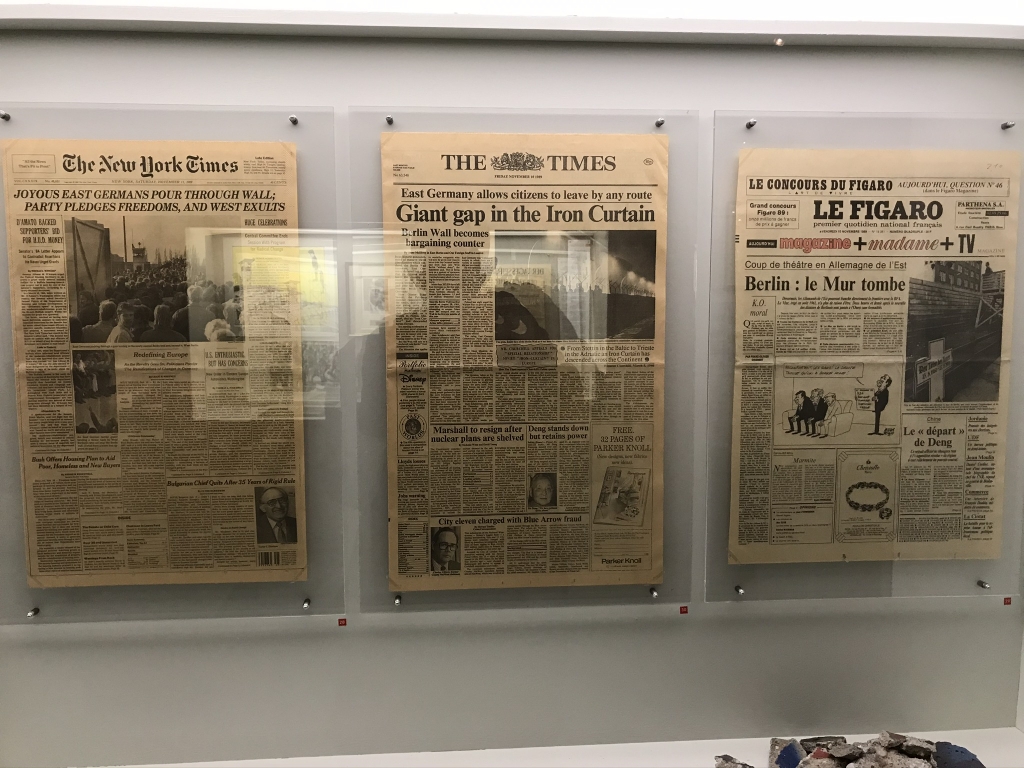
American, British, and French newspapers-of-record with their headline articles about the Berlin Wall coming down.
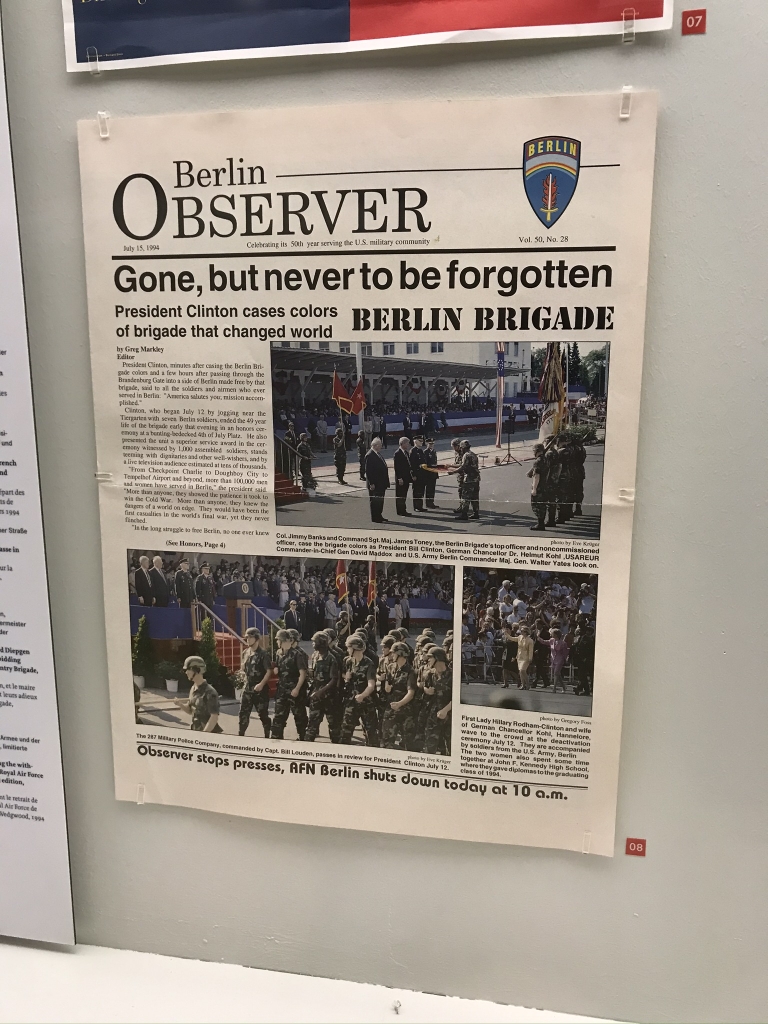
And finally, the last edition of the Berlin Observer, a newspaper for US troops in West Berlin, from July 15, 1994, announcing the end of an era. Notice the bottom line: "Observer stops presses, AFN Berlin shuts down today at 10 a.m." A whole lot of American soldiers were on their way back home not long after this was published.
So, the Allied Museum was definitely one of the more memorable museums I walked through during my long weekend in Berlin. I'm really interested in Cold War history, probably because some of the most interesting parts happened during my lifetime, as well as German history, so anything to do with the occupation of Berlin and the Berlin Wall is a perfect intersection of both. The Checkpoint Charlie and Allied Museums were both great learning experiences, although that first one was full of oppressive walls of text. I'd recommend them both, especially the Allied Museum if you want to take a selfie in front of the real, authentic Checkpoint Charlie and not the replica that's on the spot where Charlie used to stand.
Finally, I'd also recommend not starting your walk through the Checkpoint Charlie museum if you're hungry, because you will be in there a while.

